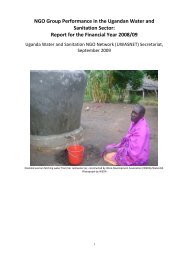Performance Report for FY 2009/10 - UWASNET
Performance Report for FY 2009/10 - UWASNET
Performance Report for FY 2009/10 - UWASNET
Create successful ePaper yourself
Turn your PDF publications into a flip-book with our unique Google optimized e-Paper software.
<strong>Per<strong>for</strong>mance</strong> <strong>Report</strong> <strong>for</strong> <strong>FY</strong> <strong>2009</strong>/<strong>10</strong><br />
Exogenous factors including seasonal and long-term changes in local water availability<br />
may also create a sustainability problem. A scoping study <strong>for</strong> the inception of the<br />
Triple-S Initiative conducted by NETWAS indicated that in many rural areas functionality<br />
of systems is contingent upon the season. Many water sources are functional during<br />
the rainy season but not in the dry season. The breakdown of water sources is more<br />
frequent during the dry season because of overuse.<br />
Limited institutional capacity is manifested by the staffing gaps at district level,<br />
and this is made worse by the limited capacity of the private sector to cope with<br />
increased water supply activities. The ever soaring number of districts increases the<br />
capacity challenge. Coupled with inadequate funding <strong>for</strong> the rural water sub-sector,<br />
these challenges have incapacitated rural water ef<strong>for</strong>ts and made sustainability of<br />
water services ever more elusive. The <strong>2009</strong> sector <strong>Per<strong>for</strong>mance</strong> <strong>Report</strong> shows that<br />
the national budgetary allocation <strong>for</strong> funding <strong>for</strong> the Water and Sanitation sub-sector<br />
has declined over the last five years from 4.9% in 2004/05 to 2.4% in 2008/09.<br />
Another challenge arises from the inadequate harmonisation and coordination. There<br />
are many players in the sector, both government and non government. Once these<br />
are not properly coordinated, sustainability will be affected. Thankfully, Uganda<br />
has developed a relatively strong service delivery framework <strong>for</strong> the provision of<br />
new services and strong coordination and synchronisation structures. The process<br />
of decentralisation and transfer of responsibility <strong>for</strong> service provision to district<br />
authorities is well structured and relatively advanced, despite suffering from a number<br />
of challenges.<br />
It is worth noting that what lies at the heart of these challenges are attitudes and<br />
behaviours. Reliable and functional rural water supply services can be provided at<br />
scale in Uganda, if a change in capacities and attitudes, at different levels in the<br />
sector can be engineered. This calls <strong>for</strong> new thinking on where and how to invest<br />
resources. This can be done through a process of learning and research. Learning<br />
is about sharing in<strong>for</strong>mation and knowledge and is a fundamental pre-requisite of<br />
per<strong>for</strong>mance improvement. Learning also contributes to better use of resources and<br />
this is vital in the current context of static or shrinking sector investments.<br />
It is this rigorous learning process that the Triple-S Initiative sets out to pursue.<br />
Triple-S is a research and learning initiative of the International Water and Sanitation<br />
Centre (IRC). It aims to pilot and test new ways of working <strong>for</strong> the delivery of rural<br />
water services in Uganda. The initiative is structured around a consortium comprising<br />
DWD/Rural Water Department, NETWAS Uganda, <strong>UWASNET</strong> and SNV.<br />
NGOs in the Ugandan Water and Sanitation Sector | 76



